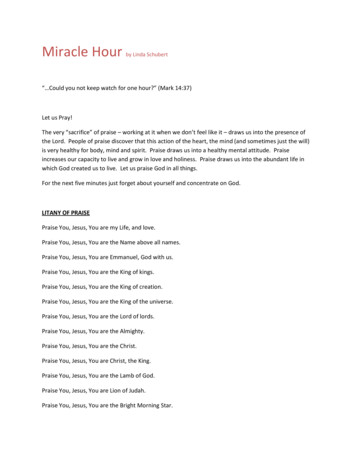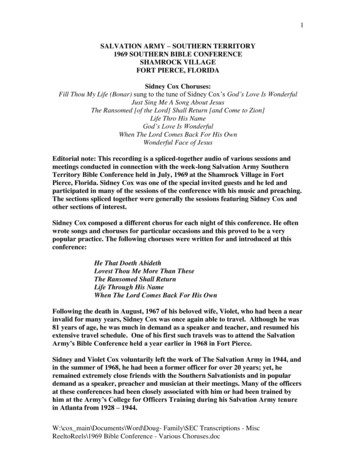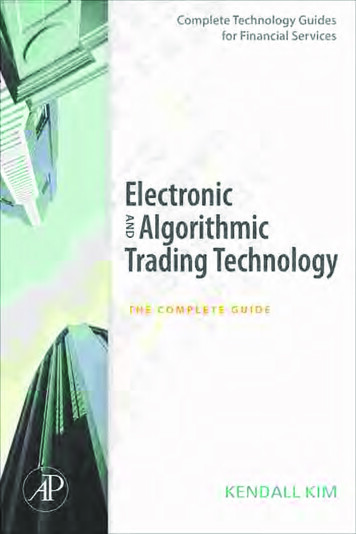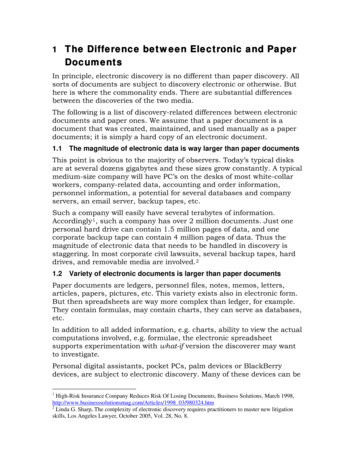
Transcription
Kim / Electronic and Algorithmic Trading Technology: The Complete Guide Kim perlims Final Proof page i13.5.2007 4:19pmCompositor Name: MRajaAdvance Praise for Electronic and AlgorithmicTrading Technology‘‘Kendall Kim’s Electronic and Algorithmic Trading Technology is well written, thoroughly researched, and logically organized. I look forward to usingthe book as a resource for class.’’—Dr. Scott Gibson, Professor of Finance at the William & Mary MasonSchool of Business‘‘In Electronic and Algorithmic Trading Technology, Kendall Kim providesvaluable insight into the highly specialized world of computer trading. Thisincludes key terminology and definitions, regulatory background, and industry drivers. In addition, the book provides an overview of the technologiesand methodologies that comprise this complex industry. Electronic and Algorithmic Trading Technology is roadmap to the world of computer trading andis essential reading for both buy- and sell-side market participants.’’—Sean Gilman, CTO, Currenex‘‘Kendall Kim has managed to give a comprehensive overview of the mechanisms, the competitive landscape, and even some forecasts on the complexand quickly evolving topic of electronic and algorithmic trading technology.Deep domain knowledge is critical to success on Wall Street; understandingcomplex market forces at work only enhances the value one can bring totheir trade. Anyone who wants to learn more about this rapidly evolvingphenomenon can benefit by reading Kendall’s book.’’—Jeff Hudson, CEO, Vhayu Technologies Corporation‘‘Comprehensive and up-to-date. Useful for both practioners and academics.’’—George S. Oldfield, Principal, The Brattle Group Washington, D.C.‘‘Electronic and Algorithmic Trading Technology’’ is an excellent resource forboth academics and financial professionals outside the domain of electronictrading who are seeking a comprehensive review of an increasingly complexand ever-changing trading landscape. Kendall Kim has managed to providean insightful, engaging, and eminently accessible summary of the core elements of algorithmic and electronic trading, the challenges faced by all tradingbusinesses today, and what lies in store for the future of trading across amultitude of asset classes.’’—Manny Santayana, Managing Director Advanced Execution Services –Equities, Credit Suisse‘‘Kendall Kim’s work is a thorough snapshot of the world of automatedtrading, with an intricate history explaining why and how we got where weare today. Packed with examples and anecdotes, it makes an impressivereference guide to the multitudes of algorithms, systems and regulations inexistence across the globe.’’—Matthew J Smalley, Director – ETD Execution Technology, UBSInvestment Bank
Kim / Electronic and Algorithmic Trading Technology: The Complete Guide Kim perlims Final Proof page ii 13.5.2007 4:19pmCompositor Name: MRajaComplete Technology Guides forFinancial Services SeriesSeries EditorsAyesha Kaljuvee and Jürgen KaljuveeSeries DescriptionIndustry pressures to shorten trading cycles and provide informationon-demand are forcing firms to re-evaluate and re-engineer all operations.Shortened trading cycles will put additional emphasis on improving riskmanagement through front-, middle-, and back-office operations. Bothbusiness and IT managers need to effectively translate these requirementsinto systems using the latest technologies and the best frameworks.The books in the Complete Technology Guides for Financial ServicesSeries outline the way to create and judge technology solutions that meetbusiness requirements through a robust decision-making process. Whetheryour focus is technical or operational, internal or external, front, middle,or back office, or buy vs. build, these books provide the framework fordesigning a cutting-edge technology solution to fit your needs.We welcome proposals for books for the series. Readers interested inlearning more about the series and Elsevier books in finance, includinghow to submit proposals for books in the series, can go to:http://www.books.elsevier.com/finance
Kim / Electronic and Algorithmic Trading Technology: The Complete Guide Kim perlims Final Proof page iii13.5.2007 4:19pmCompositor Name: MRajaElectronic and AlgorithmicTrading TechnologyThe Complete GuideKendall KimAMSTERDAM BOSTON HEIDELBERG LONDONNEW YORK OXFORD PARIS SAN DIEGOSAN FRANCISCO SINGAPORE SYDNEY TOKYOAcademic Press is an imprint of Elsevier
Kim / Electronic and Algorithmic Trading Technology: The Complete Guide Kim perlims Final Proof page iv 13.5.2007 4:19pmAcademic Press in an imprint of Elsevier30 Corporate Drive, Suite 400, Burlington, MA 01803, USA525 B Street, Suite 1900, San Diego, California 92101-4495, USA84 Theobald’s Road, London WCIX 8RR, UKThis book is printed on acid-free paper.Copyright ß 2007 by Elsevier Inc. All rights reserved.No part of this publication may be reproduced or transmitted in any form or by anymeans, electronic or mechanical, including photocopy, recording, or any informationstorage and retrieval system, without permission in writing from the publisher.Permissions may be sought directly from Elsevier’s Science & Technology RightsDepartment in Oxford, UK: phone: ( 44) 1865 843830, fax: ( 44) 1865 853333,E-mail: permissions@elsevier.com. You may also complete your request on-linevia the Elsevier homepage (http://elsevier.com), by selecting ‘‘Support & Contact’’then ‘‘Copyright and Permission’’ and then ‘‘Obtaining Permissions.’’Library of Congress Cataloging-in Publication DataKim, Kendall.Electronic and algorithmic trading technology : the complete guide / Kendall Kim. — 1st ed.p. cm.Includes bibliographical references and index.ISBN: 978-0-12-372491-5 (pbk. : alk. paper) 1. Stocks—Prices—Mathematical models.2. Programs trading (Securities) 3. Stock exchanges. I. Title.HG4636.K55 2007332.64—dc222007013849British Library Cataloguing in Publication DataA catalogue record for this book is available from the British LibraryISBN: 978-0-12-372491-5For information on all Academic Press Publicationsvisit our Web site at www.books.elsevier.comPrinted in the United States of America07 08 09 10 11 9 8 7 6 5 4 3 2 1Compositor Name: MRaja
Kim / Electronic and Algorithmic Trading Technology: The Complete Guide Kim perlims Final Proof page v 13.5.2007 4:19pmSpecial thanks to Sang Lee of the Aite Group as well as Larry Tabb andMarty Rabkin of the TABB Group whose valuable contributions andgenerosity have made this book possible.Compositor Name: MRaja
Kim / Electronic and Algorithmic Trading Technology: The Complete Guide Kim perlims Final Proof page vi 13.5.2007 4:19pmCompositor Name: MRaja
Kim / Electronic and Algorithmic Trading Technology: The Complete Guide Kim perlims Final Proof page vii 13.5.2007 4:19pmCompositor Name: MRajaContentsAbout the AuthorSeries PrefaceIntroductionxiiixvxixCHAPTER 1Overview of Electronic and Algorithmic Trading11.1Overview11.2The Emergence of Electronic Trading Networks21.3The Participants41.4The Impact of Decimalization61.5The Different Faces of Electronic Trading81.6Program Trading and the Stock Market Crash of 1987101.7Conclusion13CHAPTER 2Automating Trade and Order Flow2.1Introduction1515vii
Kim / Electronic and Algorithmic Trading Technology: The Complete Guide Kim perlims Final Proof page viii 13.5.2007 4:19pmviiiCompositor Name: MRajaContents2.2 Internal Controls162.3 Trade Cycle172.4 Straight-Through Processing and Trade Automation192.5 Data Management202.6 Order Management Systems222.7 Order Routing252.8 Liquidity Shift262.9 Conclusion28CHAPTER 3The Growth of Program and Algorithmic Trading293.1 Introduction293.2 A Sample Program Trade313.3 The Downside of Program Trading333.4 Market Growth and IT Spending363.5 Conclusion38CHAPTER 4Alternative Execution Venues394.1 Introduction394.2 Structure of Exchanges404.3 Rule 390434.4 Exchanges Scramble to Consolidate444.5 Arguments Against Exchanges444.6 The Exchanges in the News464.7 Conclusion49CHAPTER 5Algorithmic Strategies515.1 Introduction51
Kim / Electronic and Algorithmic Trading Technology: The Complete Guide Kim perlims Final Proof page ix 13.5.2007 4:19pmContentsCompositor Name: MRajaix5.2Algorithmic Penetration525.3Implementation Shortfall Measurement545.4Volume-Weighted Average Price565.5VWAP Definitions585.6Time-Weighted Average Price605.7Conclusion62CHAPTER 6Algorithmic Feasibility and Limitations636.1Introduction636.2Trade Structure646.3Algorithmic Feasibility646.4Algorithmic Trading Checklist666.5High Opportunity Cost676.6Newsflow Algorithms686.7Black Box Trading for Fixed-Income Instruments696.8Conclusion70CHAPTER 7Electronic Trading Networks717.1Introduction717.2Direct Market Access717.3Electronic Communication Networks757.4Shifting Trends797.5Conclusion80CHAPTER 8Effective Data Management8.1Introduction8383
Kim / Electronic and Algorithmic Trading Technology: The Complete Guide Kim perlims Final Proof page x 13.5.2007 4:19pmxCompositor Name: MRajaContents8.2Real-Time Data848.3Strategy Enablers858.4Order Routing878.5Impact on Operations and Technology888.6Conclusion89CHAPTER 9Minimizing Execution Costs919.1Introduction919.2Components of Trading Costs929.3Price Impacts with Liquidity939.4Cost of Waiting979.5Explicit Costs—Commissions, Fees, and Taxes989.6Conclusion100CHAPTER 10Transaction Cost Research10310.1Introduction10310.2Post-Trade TCR10510.3Pre-Trade TCR10610.4The Future of Transaction Cost Research10810.5Conclusion109CHAPTER 11Electronic and Algorithmic Trading for Different Asset Classes11111.1Introduction11111.2Development of Electronic Trading11311.3Electronic Trading Platforms11611.4Types of Systems119
Kim / Electronic and Algorithmic Trading Technology: The Complete Guide Kim perlims Final Proof page xi 13.5.2007 4:19pmContentsCompositor Name: MRajaxi11.5TRACE—Reform in Transparency12011.6Foreign Exchange Markets12211.7Conclusion123CHAPTER 12Regulation NMS and Other Regulatory Reporting12512.1Introduction12512.2Regulatory Challenges12612.3The National Market System12712.4The Impact of Regulatory NMS13112.5 Markets in Financial Instruments Directive in Europe13312.6Regulatory and Exchange Reporting13512.7Example of an Exchange Data Processing System13812.8Conclusion139CHAPTER 13Build vs. Buy14113.1Introduction14113.2Vendor as a Service Provider14313.3Striving to Stand Out14713.4The Surge of Electronic Trading ThroughRegulatory Changes14913.5Hedge Fund Systems—Outsource or In-House?14913.6Conclusion152CHAPTER 14Trading Technology and Prime Brokerage15314.1Introduction15314.2Prime Broker Services154
Kim / Electronic and Algorithmic Trading Technology: The Complete Guide Kim perlims Final Proof page xii 13.5.2007 4:19pmxiiCompositor Name: MRajaContents14.3The Structure of Hedge Funds15714.4The Impact of Increased Trade Automation15814.5Different Markets and Asset Classes15914.6The Prime Brokerage Market16014.7Conclusion161CHAPTER 15Profiling the Leading Vendors16315.1Introduction16315.2Profiling Leading Vendors16615.3Order Management Systems175Appendix:The Implementation of Trading Systems181Glossary of Terms187Index199
Kim / Electronic and Algorithmic Trading Technology: The Complete Guide Kim perlims Final Proof page xiii 13.5.2007 4:19pmCompositor Name: MRajaAbout the AuthorKendall Kim is a Business Analyst based out of New York City and lives inConnecticut. He specializes in delivering technology solutions to Wall Streetsecurities firms. In this role he has been responsible for the specification andimplementation of large trading, risk management, and real-time marketdata systems. Kendall holds a bachelor’s degree in Economics from BostonUniversity, Boston, MA and a master’s degree in Business Administrationfrom The College of William and Mary, Williamsburg, VA.xiii
Kim / Electronic and Algorithmic Trading Technology: The Complete Guide Kim perlims Final Proof page xiv 13.5.2007 4:19pmCompositor Name: MRaja
Kim / Electronic and Algorithmic Trading Technology: The Complete Guide Kim perlims Final Proof page xv 13.5.2007 4:19pmCompositor Name: MRajaSeries PrefaceKendall Kim’s book Electronic and Algorithmic Trading Technology is animportant addition to the Complete Technology Guides for Financial ServicesSeries, the first series of its kind to focus specifically on financial technologytrends, challenges, and their solutions. The book could not have come tothe market at a more opportune moment. The financial trading industry,with broker-dealers, buy-side funds, exchanges, and venues of trade execution as its primary players, is experiencing a historical transformation. Thisenormous change is being driven by deep underlying factors shaping globalmarkets today, including (1) the consolidation of execution venues andthe birth of global exchanges, (2) competitive pressures on broker-dealersto offer electronic services and best order execution to their clients, and(3) increased regulatory requirements from financial authorities to improvetransparency for all market participants.Before reviewing some of the highlights in the chapters of this new andexciting book, a note of clarification on basic terminology is in order. Whentalking about the evolution of trading technology, it is important to distinguish among electronic trading, program trading, and algorithmic trading.Electronic trading refers to connecting the trade counterparties to oneanother through an electronic execution protocol and eliminating whatwas known as voice brokerage. This wave of innovation began in the1980s and is still taking place. Secondly, program trading refers to therequirement of executing large baskets of shares. Finally, algorithmic trading, in its simplest (but not all-inclusive) definition, refers to algorithms forbreaking down blocks of trade orders to obtain best price and executionxv
Kim / Electronic and Algorithmic Trading Technology: The Complete Guide Kim perlims Final Proof page xvi 13.5.2007 4:19pmCompositor Name: MRajaxvi Series Prefacewhile minimizing market impact. In a way, these are also the basic threesteps of the evolution of trading with most market participants continuing toinnovate and grow in all three dimensions. Note that this maturation istaking place both in terms of technology as well as financial modeling andanalytics, since they go hand in hand. Kendall Kim’s book discusses all threeareas of trade automation and innovation in detail, with particular focus onelectronic and algorithmic trading, providing research figures and statisticsthroughout to enrich the reader’s experience.The first three chapters of the book introduce the reader to key concepts,the trade life cycle, and factors driving the growth of electronic trading inrecent years. The book begins with Chapter 1: Overview of Electronic andAlgorithmic Trading, which defines important ideas and gives a historicalperspective on the emergence of program and algorithmic trading. We learnhow decimalization, which changed the way the New York Stock Exchangequoted security prices, impacted the market, and how Electronic Communication Networks (ECNs) and multilateral trading facilities (MTFs) emergedto compete with monopolistic central exchanges. The chapter covers differentaspects of electronic trading, such as duration averaging, dynamic hedging,and index arbitrage, and touches on the connectivity protocol known asFIX (Financial Information Exchange), which is the technological basis forincreased connectivity. Chapter 2: Automating Trade and Order Flow coversthe trade life cycle from beginning to end. It highlights the major steps in thetrade life cycle, such as trade confirmation, settlement, and reconciliation.It argues that changing back-office processes are, in fact, key enablers offinancial innovation. It gives perspective on the automation of trading fromboth a technology and a management point of view, describing importantconcepts such as direct market access (DMA), smart order routing, andstraight-through processing (STP). Chapter 3: The Growth of Program andAlgorithmic Trading reviews statistics like average daily volume (ADV) whoseexploding number is attributable to the rising prevalence of program andalgorithmic trading. The chapter also studies the correlation between the risein program trading and the increase in IT spending in the financial servicesindustry.Chapter 4: Alternative Execution Venues explains the drivers behind theneed for these new venues, such as speed of execution, regulatory pressures,cost savings, direct market access (DMA), and the desire for anonymity. Thechapter compares the electronic trading networks to exchanges, and discusseseconomic disadvantages of the latter, including factors like monopoly andexternalities, which created the need for alternative securities markets. Finally, it reviews various exchanges globally that are likely to be most affectedby the growth of execution venues.
Kim / Electronic and Algorithmic Trading Technology: The Complete Guide Kim perlims Final Proof page xvii 13.5.2007 4:19pmSeries PrefaceCompositor Name: MRajaxviiChapter 5: Algorithmic Strategies describes the major algorithms in detail,with an eye on the goal of each strategy. The reader learns basic conceptslike implementation shortfall and execution benchmarks such as VWAP(Volume-Weighted Average Pricing) and TWAP (Time-Weighted AveragePricing). The chapter shows how market practitioners use these algorithms,and shows which market participants offer the best strategy executions.Chapter 6: Algorithmic Feasibility and Limitations takes the topic of algorithms further, introducing the central notion of transaction cost analysis(TCA). The reader is introduced to a set of analytical tools, with a framework for deciding which types of algorithms are suited to which objective ofa trader or investor. Chapter 7: Electronic Trading Networks tackles the newset of liquidity providers know as Electronic Communication Networks(ECN) and multilateral trading facilities (MTF). It goes into more detailregarding shifting trends and direct market access (DMA) technology.Chapter 8: Effective Data Management emphasizes the importance of havinga strategy in place for managing this data, especially given the value ofdetailed and clean data for any kind of accurate analysis. Chapter 9: Minimizing Execution Costs and Chapter 10: Transaction Cost Research delveinto the details of minimizing costs associated with any kind of traderexecution, covering both the explicit and implicit costs. They also providea wide range of market statistics on how the cost varies depending on themarket, order type, and size of the order.It comes as little surprise that equity markets were the first ones to adoptthis type of trading, but what about other major asset classes such as fixedincome, foreign exchange, and commodities? Chapter 11: Electronic andAlgorithmic Trading for Different Asset Classes reviews how electronic trading has taken ground depending on the asset class in question, providingsome interesting and revealing answers to which classes are most likely to beaffected next and how your area in the industry might be changed by it.Of course, every part of the industry, including the new asset classesentering into the electronic trading world, is impacted by regulatory reporting requirements set in place by financial authorities. Chapter 12: RegulationNMS and Other Regulatory Reporting examines the philosophy behindcompliance and regulatory laws, describing various types of reporting suchas electronic blue sheets, Regulation NMS, and DPTR in the United Statesand MiFID in Europe. It reviews who is affected by these requirements andthe mechanisms by which an organization can prepare itself to meet them.The last three chapters of the book introduce the technology aspects ofelectronic and algorithmic trading in detail, starting with the technologiesundertaken by vendors and prime brokers. Chapter 13: Build vs. Buy investigates what goes into the all-important decision-making process of determining whether to build or buy electronic-trading-related technologies,
Kim / Electronic and Algorithmic Trading Technology: The Complete Guide Kim perlims Final Proof page xviii 13.5.2007 4:19pmxviiiCompositor Name: MRajaSeries Prefaceproviding readers with the basic principles and criteria under which suchdecisions should be made. Prime brokers are sell-side players that offerleverage, trade processing, and clearance services for buy-side firms, suchas hedge funds, and are strong participants in the electronic and algorithmictrading arena. It is then not surprising that prime brokers are often at theforefront of providing electronic and algorithmic solutions, both analyticallyand technologically, particularly on the back end. Chapter 14: TradingTechnology and Prime Brokerage gives the reader an insider view of howthese players build their electronic trading technology. Given the speed ofelectronic execution and the number of transactions occurring per day,technologists have to consider how to deal with the enormous amounts offinancial data being generated by electronic trading. Finally, the book endswith Chapter 15: Profiling the Leading Vendors and gives the reader the toolsto ‘‘go algorithmic,’’ as it is often said in the industry, right after reading thebook, that is, today or in the worst case, tomorrow.In summary, Kendall Kim’s Electronic and Algorithmic Trading Technologyis a unique book both in terms of the level of detail as well as the breadthof its scope. If you are a senior manager at a sell-side or a buy-side firm, anexecution venue; or a broker, regulator, or fund manager in charge of implementing technology systems for your business; or just curious about where thefuture of finance is heading, this book provides key insights and guidance onthe fundamentals of electronic trading and the technological solutions forimplementing them.Series EditorsAyesha KaljuveeNew York, USAJürgen KaljuveeLondon, UK
the book as a resource for class.’’ —Dr. Scott Gibson, Professor of Finance at the William & Mary Mason School of Business ‘‘In Electronic and Algorithmic Trading Technology, Kendall Kim provides valuable insight into the highly specialized world of computer trading. This inclu










